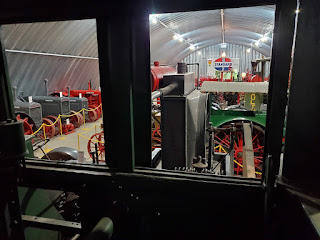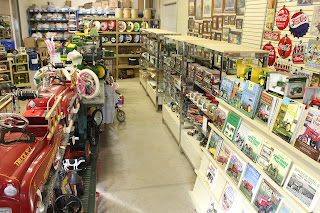The Minneapolis 35-70 was built by the Minneapolis Threshing Machine Company in Hopkins, Minnesota from 1920-1929. It is powered by a 1486 cubic inch 4-cylinder engine fueled with kerosene. It developed a maximum belt horsepower of 74.0 and drawbar horsepower of 52.55 in the Nebraska tests done from May 21 to June 4, 1920. The engine has a 7.25” bore and 9” stroke and was rated at 550 rpm. The transmission has two forward gears at 2.0 and 2.5 mph, and one reverse at 1.7 mph. The tractor is 17’-2” long, 9’ wide, 10’-2” high, and weighs 22,500 pounds. It is rated to pull a 6-10 bottom plow, depending on soil conditions.
The 35-70 was built in an era when the larger tractors were built using internal combustion engines on a frame similar to those used on steam traction engines. These tractors were used to pull implements or to provide stationary power for threshing machines and feed mills. The large tractors such as this were expensive to buy and cumbersome to drive and not well suited for smaller farms. Many manufacturers began making smaller, less expensive tractors better suited for smaller farms, and the sales of the larger ones dwindled. Because of the amount of steel in them, many of these tractors as well as many steam traction engines were scrapped during World War II so the steel could be recycled to help the war effort.
In 1929 the Minneapolis Threshing Machine Company, Minneapolis Steel & Machinery Company, and Moline Plow Works merged to become the Minneapolis-Moline. The new company had its headquarters in Hopkins, with plants in Hopkins, Minneapolis at Hiawatha Avenue & Lake Street, and in Moline, Illinois.
Minneapolis-Moline acquired the Avery farm machine company in 1951, and was then acquired by The White Motor Company in 1963.
Here are links to an article and video on the 35-70:
https://www.bemidjipioneer.com/news/4106588-renovation-13-ton-100-year-old-tractor-team-effort
https://www.youtube.com/watch?v=_6M8I79NLXI
The operator's platform on this tractor is large enough to accommodate two people, but has no seat. Below are some photos taken from the operator's platform. Notice the exposed push rods and rocker arms on the engine, as well as the height of the platform compared to other tractors in the museum.























